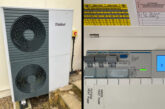
Steve Dyson, Market Manager at Hager UK, considers the increased importance of usability when installing and commissioning lighting controls.
Usability is a term that is often up for discussion. Of course it encompasses, in its simplest terms, ease of use, but it also means so much more.
Lighting is an important factor in building design, from its aesthetics, to functionality, to energy efficiency. Pre-fabricated lighting systems have been around for some time now however they have since evolved to meet the demands of tomorrow’s buildings with more recent developments such as the Klik Bluetooth multi-channel Lighting Control Module (LCM).
Lighting controls are used in lighting design projects to achieve a high-quality, energy efficient lighting system. Specifying a layered lighting and control system that utilises natural light, gives the occupants full management of the lighting. But this is all well and good as long as the system is usable – if not the controls could potentially have the opposite of the desired effect.
“When we design pre-fabricated lighting systems we need to understand the goals for usability in each stage of the project as well as decide on the best techniques for usability evaluations.”
Rather than over-simplifying the situation it is important to consider each user’s requirements in order to satisfy the element of usability – in the case of lighting design, there are a number of ‘users’: consultants; specifiers; installers and end-users i.e. facilities managers, homeowners or building occupants. When we design pre-fabricated lighting systems we need to understand the goals for usability in each stage of the project as well as decide on the best techniques for usability evaluations. Essentially there are five characteristics: to be effective, to be efficient, to be engaging, to be error tolerant and to be easy to learn.
Below is a combination of considerations carried out by Hager when designing lighting systems to ensure usability across customer groups:
- Time taken for a new user to learn the system.
- Speed of an experienced user to complete a task.
- How long it takes for service and maintenance?
- Frequency of errors made when a user is engaged with the system.
- If errors are made, it must be considered as to how often and how severe?
- How comfortable does the user feel with the product?
- Quantity of advantages evaluated by the user.
Ultimately, it is in the best interest of specifiers and building designers to select products that will make the lives of installers and end-users easier.
App-based technology
It cannot be understated how important commissioning is to the ultimate success of a lighting control system. If a lighting control system is not commissioned, it may result in greater energy consumption than a building without any controls at all. Commissioning is defined as the final adjustment, calibration, and tuning of the various components after they have been installed and the space is occupied. This process requires the participation of the building owner, a commissioning agent, the lighting designer, the electrical engineer, a manufacturer’s representative and building maintenance personnel.
According to Yahoo-owned mobile analytics firm, Flurry, app usage grew by 76% in 2014 alone – clearly demonstrating society’s technological shift in behaviour. Klik LCM is programmed via the KlikLink App offering unrivalled potential for tailored lighting requirements. This has been proven through various installations such as a recent £13.5m educational development, The Aylesbury Centre. The key selling point for electrical contractor, Darke & Taylor was the simplicity in the functionality behind the system making it easy to install and commission, as well as use.
Installation time savings
Like any pre-fabricated product, structure or materials, pre-fabricated wiring systems are known for their time saving ability speeding up installations and maintenance tasks. Compared with traditional fixed wiring, systems like Klik – which delivers up to a 70% reduction in labour time – they are fast-becoming the obvious choice for specifiers and building owners in order to reduce the costs of installers being on-site. Furthermore, Klik LCM’s on-load isolation allows individual emergency luminaries to be unplugged, simulating a power failure during “walk tests”. And remote control dimming is another form of manual dimming that is well suited for retrofit projects to minimise rewiring time.
Reactive environments
It would be difficult to have overlooked that smart buildings are one of the biggest influencers in the way we design tomorrow’s buildings. People are becoming more accustomed to smart technologies and lighting plays an integral role in this area. With regards to lighting systems, occupancy sensors eliminate the need to control lighting manually, as well as saving energy by automatically switching off when the area is vacant.
Manual dimming also gives occupants of a space an added degree of control and satisfaction, as well as an opportunity to save energy.
Traditionally a word coined for the web design industry, usability is becoming more and more influential in many other walks of life. The construction industry is evolving every day and there are many conversations surrounding the buildings of tomorrow with the outlook for the structures that surround us every day proving largely optimistic. Architects predict that these buildings won’t be as flashy, but they’ll be far more useful on an everyday basis and this clearly demonstrates the increased necessity for lighting systems that deliver usability.








